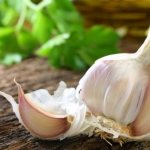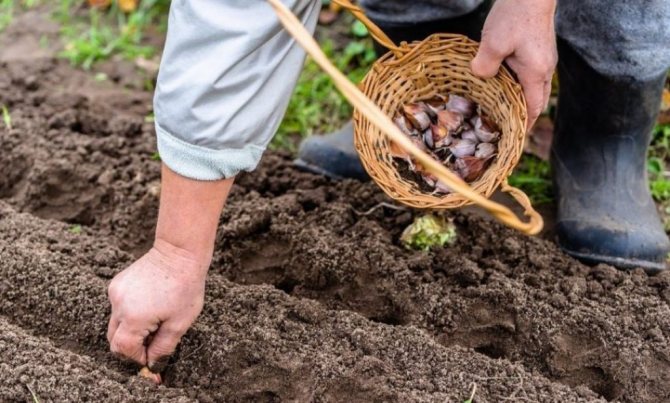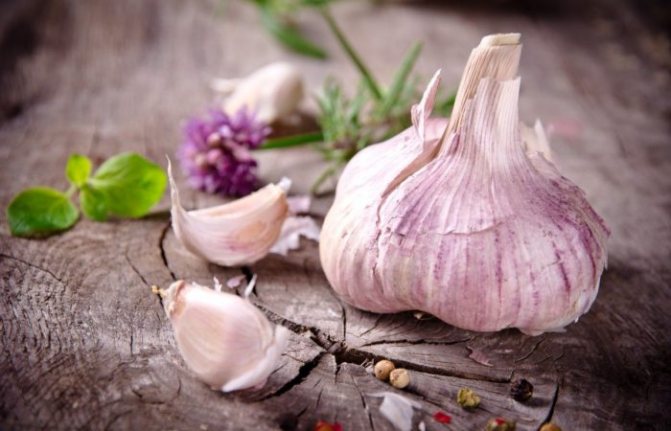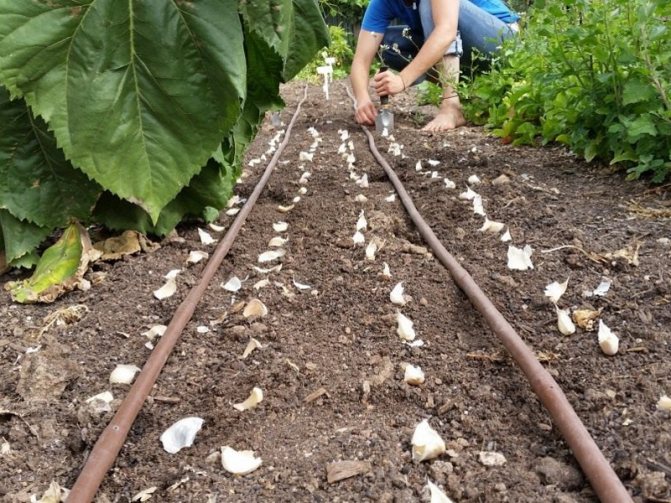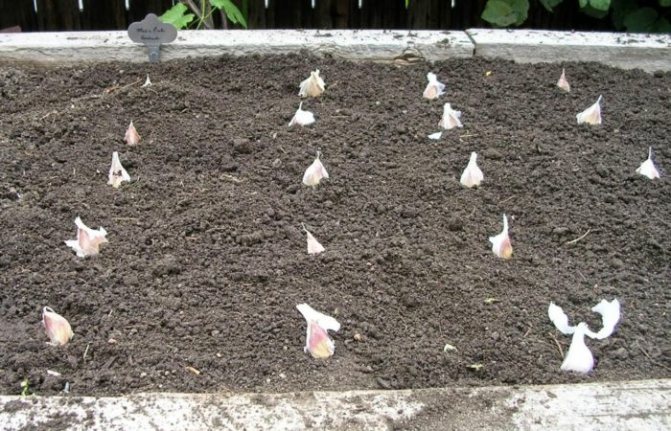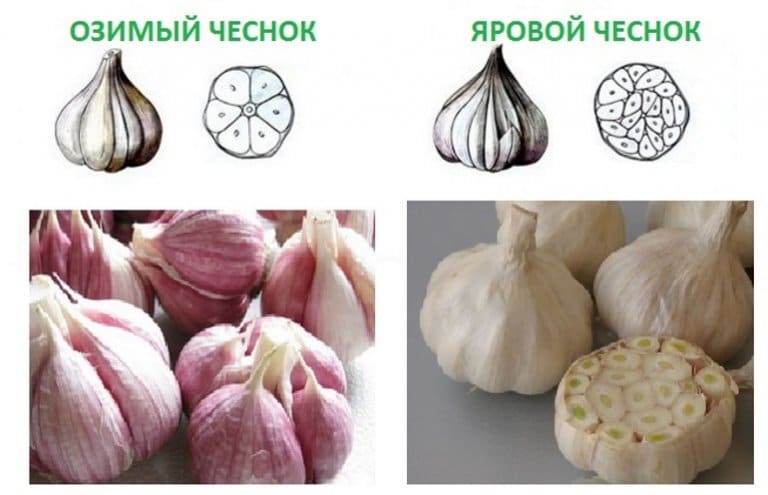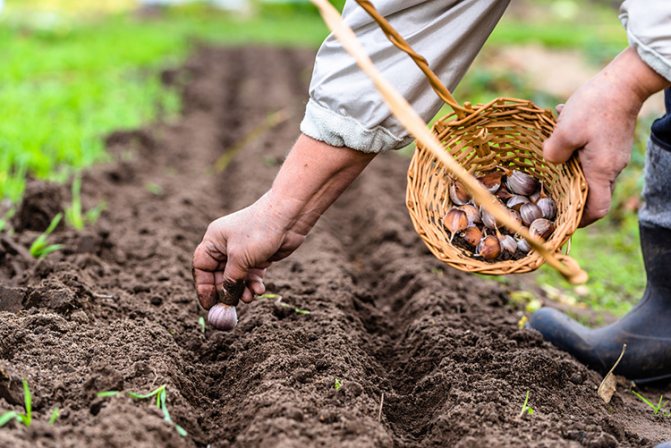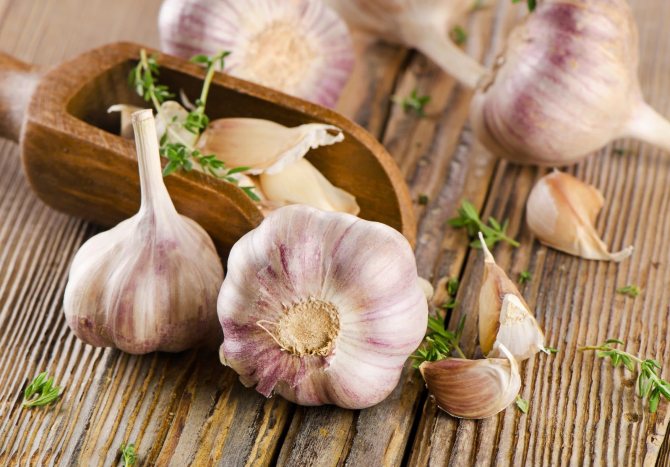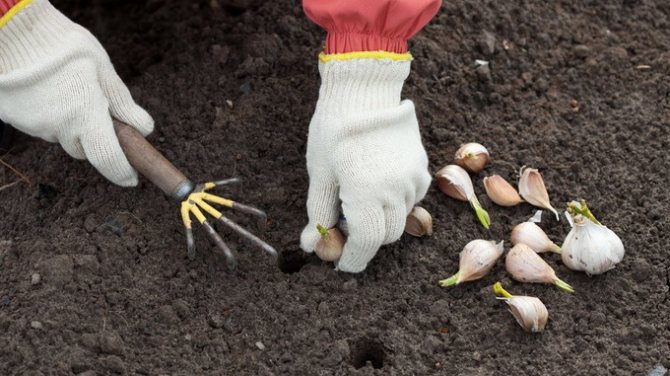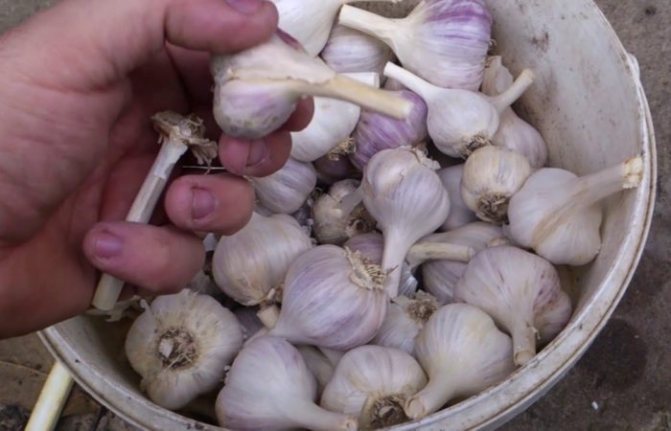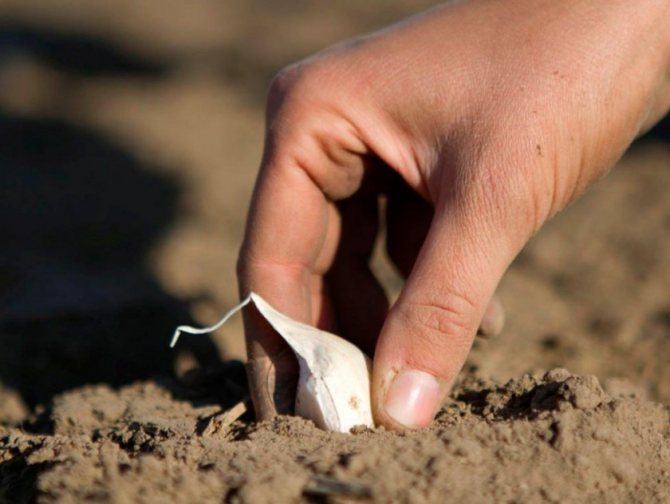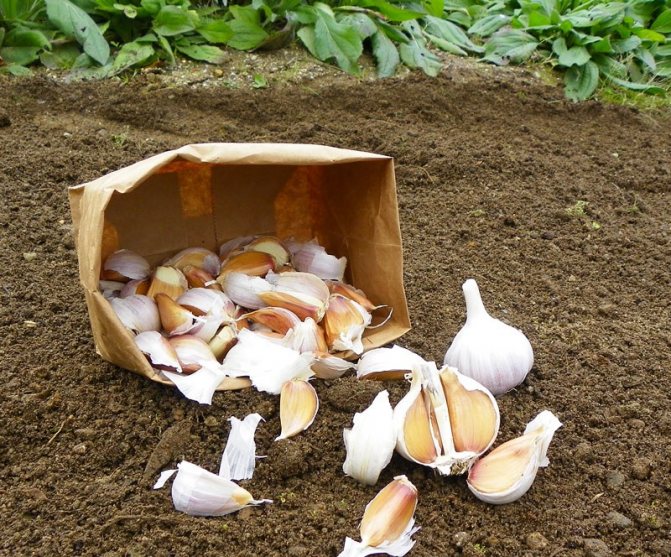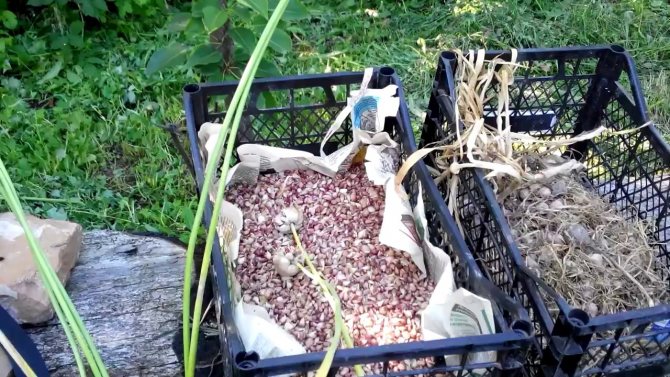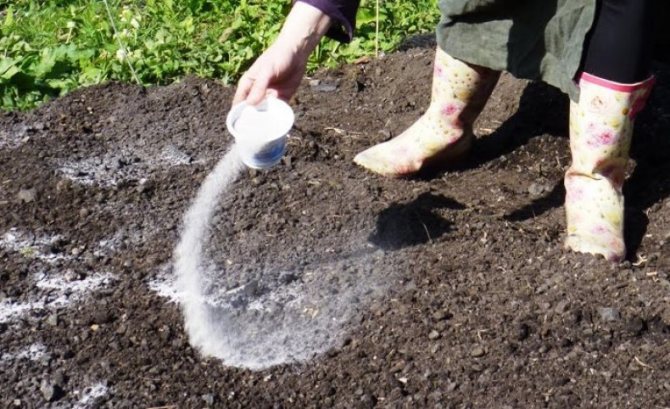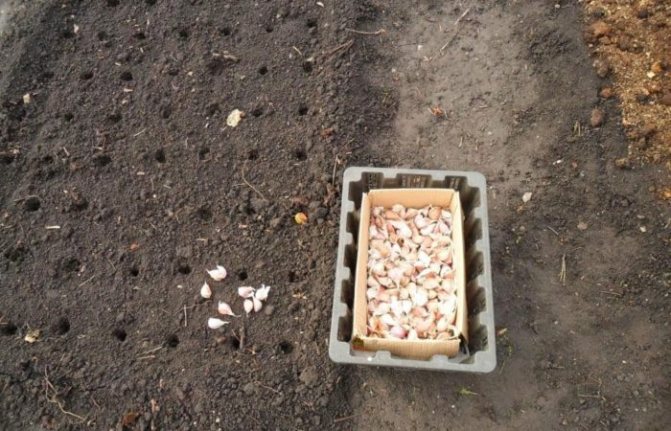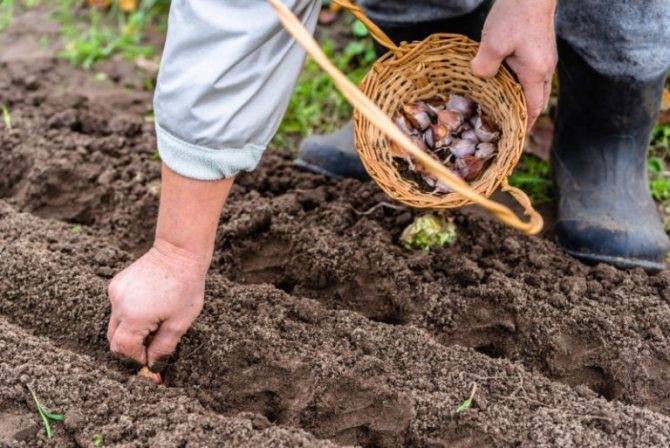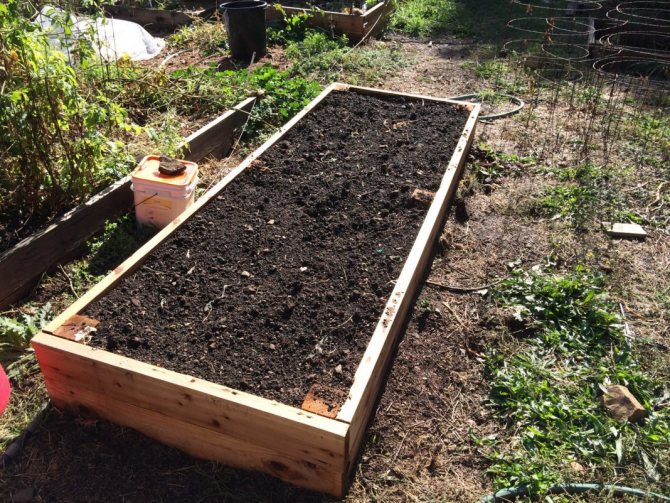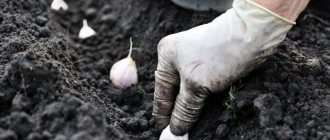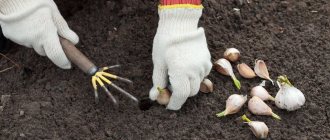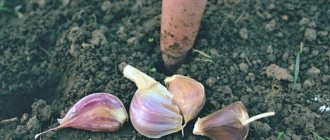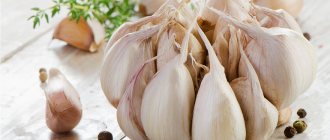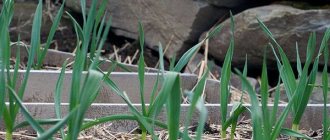Winter and spring garlic: the role of agricultural technology
By planting time, winter and spring garlic are distinguished. Winter - planted "before winter", in the fall. Spring - planted "in the summer", in the spring.
For both winter crops and spring plantings, proper agricultural technology is important. It determines the growth conditions and crop yield, namely:
- Preparing the soil in the garden creates a supply of nutrients, soil fertility.
- Planting depth is important for winter garlic. Winter hardiness and the probability of freezing depend on it.
- The distance between the garlic cloves is important for the development and nutrition of plants. Planting too close leads to co-shading and nutrient deficiencies. To the formation of small heads and small denticles.
- Subsequent watering determines the growth and development of stems, the formation and size of roots and tubers. With sufficient watering, the harvest of garlic is larger, the heads are larger and juicier. With insufficient watering, the cloves of garlic are small, dry and not juicy.
Winter planting of garlic: benefits
Planting in the fall has an advantage over summer plantings:
- The size of the heads of winter garlic is larger than that of spring garlic. The reason is the good vegetation of the plants. Garlic bushes have a long growing period. They will receive a lot of moisture and have time to form a strong root system.
- Autumn plantings of garlic give early spring greens.
- Winter garlic shoots - forms an arrow with peduncles. It is used for growing garlic bulbs and for garlic selection.
Planting garlic before winter is fraught with freezing. How to plant garlic correctly so that the seed is preserved and gives a good harvest?
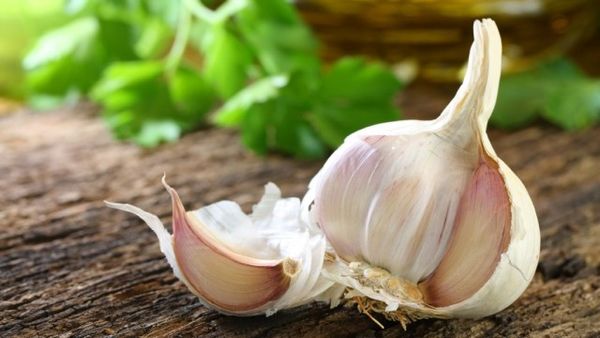
Useful Tips
Some subtleties that will help gardeners when growing winter garlic:
- So that the bulbs on the peduncles do not spill out on the ground, they are cut off until the film covering the inflorescence bursts.
- You can plant winter garlic in spring with bulbs for growing one-tooth.
- If for some reason they did not manage to plant winter garlic in the fall, you can try to do it in the spring, although success is not guaranteed. To prepare the planting material for spring planting, at the end of winter, it is kept in moist moss until roots appear, and then stored in a cold basement, if possible, covered with snow.
- It is necessary to remove garlic arrows in a timely manner (with pruning shears or garden shears) in order to increase the yield of garlic.
- Top dressing of garlic is carried out only during the period of leaf growth.
It is not difficult to learn how to plant for the winter. A little effort and useful products will always be on your table. In addition, winter garlic will help to rationally use the area of the garden and will be a good predecessor for other crops.
Features of agrotechnology of garlic
We list a few important points that you need to know and take into account when planting in autumn.
Planting time
It is recommended to plant garlic in the fall 2 weeks before the onset of frost. This time is approximate. It is better to determine the timing by night temperatures. As soon as the first frosts appear, it's time to plant the garlic in the ground.
Soil preparation
The garden should be prepared in advance, one month before planting. The preparation of the garden consists in fertilizing it. It is necessary to add a complex of fertilizers from organic matter and chemistry to the soil. What is recommended to be added before planting garlic (data are given in terms of 1 sq. M):
- compost - 1 bucket
- ash-fluff - 1 glass
- superphosphate, potassium fertilizer and ammonium nitrate - 1 tablespoon each
What else to consider: the soil must be loose. Oxygen access to plant roots is necessary for the formation of large denticles. Therefore, the best soil is sandy loam or loam. If the soil is heavy, clayey, it is necessary to add sand and peat.
Preparing the cloves
The garlic head is disassembled into separate cloves. For planting, take the outer large teeth. Internal small teeth are not used for planting.
For antiseptic treatment, the cloves are dipped in a strong salt solution for 2-3 minutes. Dilute 2 tablespoons of table salt in 1 glass of water (200 ml). After - the cloves are dried and planted in the ground.
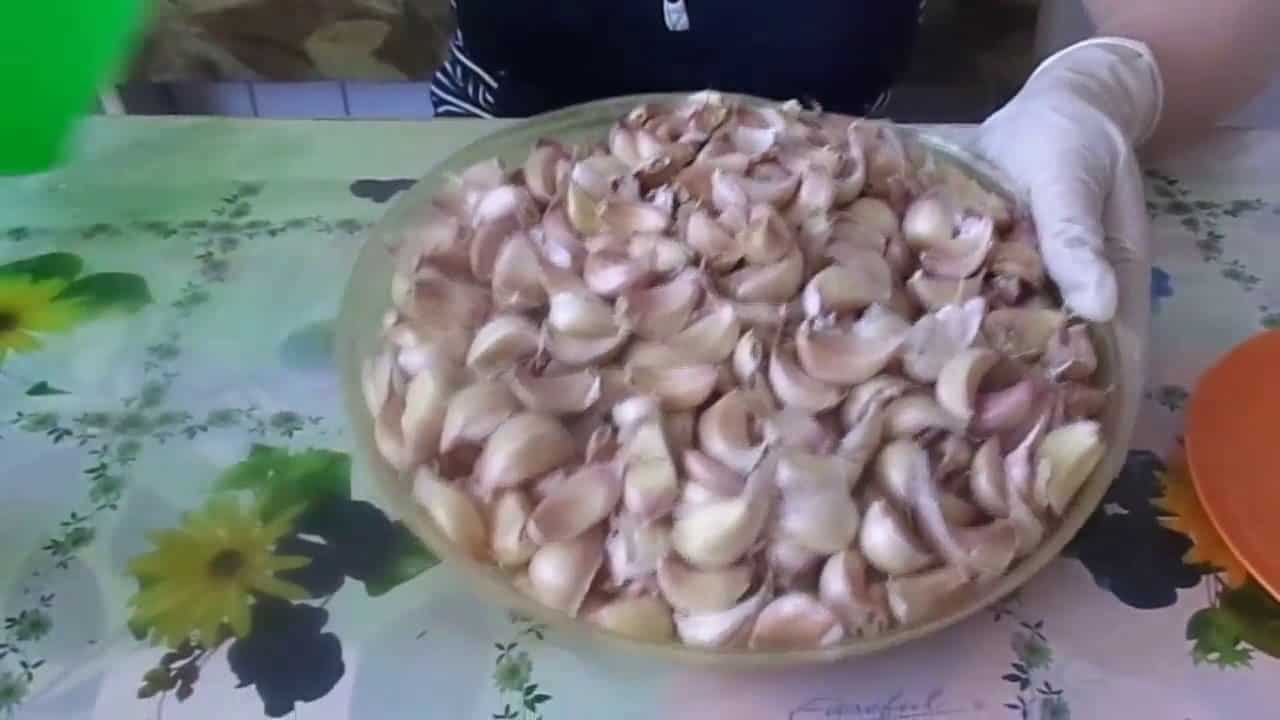

Planting depth
The distance between the bottom of the clove, its bottom and the soil surface is called the planting depth. Depth size depends on:
For sandy loam soil, the planting depth is determined 2 times the height of the clove - for autumn plantings. And 3 ... 4 cm to the upper "tail" of the prong (or + 3 ... 4 cm to its length) - for planting in summer. That is, the larger the size of the cloves of garlic, the deeper they need to be buried.
Deep burial facilitates good wintering. In winter planting, large heads of garlic are used, since they can be planted deep. Small teeth planted shallow near the surface will freeze.
In dense soil, garlic cloves are planted higher than in sandy loam. Planting deep in dense soil can lead to winter "pushing" of the teeth out of the soil. Therefore, in clay soil, the planted garlic can freeze out - due to the fact that the soil "pushes" it to the surface. To prevent this from happening, in the fall, sand is introduced into the upper layers of the soil (for digging).
Distance between teeth
Garlic is usually planted in rows. The distance between individual teeth in a row is chosen from 10 to 15 cm (depending on their size). The distance between adjacent furrows is made from 20 to 25 cm. Why is it important to follow these recommendations?
The free arrangement of the plants provides their illumination. This promotes the growth of green feathers and the formation of roots. Plants are "ventilated" and get sick less, various rot and fungal diseases appear less often.
Planting method: furrows and grooves
You can plant the cloves of garlic in the prepared long furrows. Important: the soil at the landing site must be compacted. This will make it easier for the garlic to form its root system.
Read also Blacks the leg under the bud of the rose flower
A shovel shaft is conveniently used to compact the furrow. It is placed in the furrow and pressed down.
The second option for planting the cloves is in separate recesses. Here you can use a shortened shaft with a pointed end. At the end of the shaft, the depth of the clove is indicated (with a colored pencil or electrical tape, paint). The shaft is pressed into the ground to the indicated level. A clove is planted in the resulting depression and covered with soil on top.
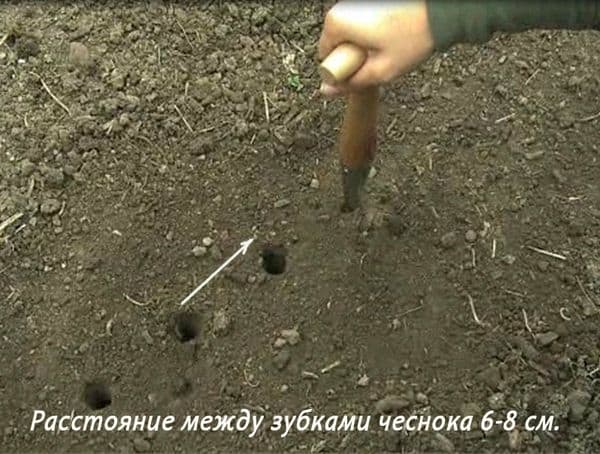

Note: it is optimal for germination, so that the bottom of the soil is dense, and the top is loose.
Garlic care
If you plant the garlic correctly, then the care will be minimal. It consists of watering, fertilizing and pest control.
If the organic matter of the soil is poor, apply phosphorus fertilizers before planting. You need 1 tablespoon of superphosphate, 500 ml of wood ash and 2-3 tablespoons of potassium sulfate to dissolve in a bucket of water. Fertilizers are best applied by drip irrigation.
In the spring, when the frosts pass, the main remedy is urea. Dissolve 1 tablespoon of urea in 1 bucket of water. Water the seedlings with a solution.
Watering is carried out every 7-10 days. The ground should not be too wet or dry. Be sure to clear the weeds from the garden. They spoil the root system of the onion plant.
Let's summarize
Autumn planting of garlic is carried out to a depth of 2 times more than the height of the clove. The soil is fertilized before planting and, if necessary, sand is added. The bottom of the furrows is compacted. The denticles are planted at a distance of 10-15 cm in a row, 20-25 cm are left between the furrows.
There are several ways to grow and propagate garlic. It is planted with seeds, teeth and bulbs. The scheme of planting garlic depends on the choice of planting material. Our article provides information on each method separately.
How to plant garlic in spring
Spring varieties of garlic are planted in early spring. Before this, the heads intended for planting should be disassembled into teeth, then put the resulting material in a bag and sprinkle with water. In this form, the cloves should be for several days. During this period, they will wake up and may even take root.
It is not necessary to cultivate the land in a special way before planting, provided that in the fall it received the necessary set of fertilizers. To protect the future harvest from pests, you can pre-treat the soil with a solution of vitriol in the proportion of one tablespoon per bucket of water. In spring, it is not correct to plant garlic deeply - the height of the soil should be no more than three centimeters. The frost is already over, which means that additional thermal protection is not required. After the topsoil warms up to a temperature of +5 degrees, you can start planting work.
Most often, this period occurs in April. Each tooth is spaced approximately three or four fingers apart.
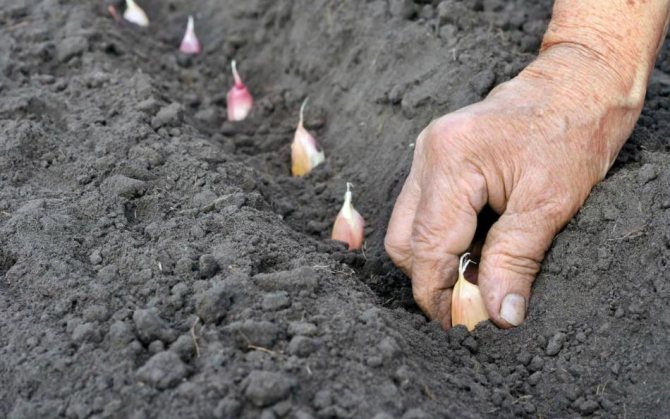

It is better to adhere to the rule - to distribute teeth with the same size on the beds
The harvest time will depend on the size of the planting material, so they should be divided at the initial stage.
In order to save money, many housewives plant different crops next to each other. It should be remembered that garlic does not tolerate the neighborhood with onions and cucumbers. It cannot be planted in the same place every year.
On each side of the bed, it is desirable to have small sides, so moisture after watering or rains will last longer for the necessary nutrition of the plant. Some housewives, before starting work, treat the land with a saline solution - three tablespoons of salt per 10 liters of water.
After planting spring garlic, abundant watering is required. It is cut only after the first shoots appear.
Types and varieties of garlic
There are two main types of this crop: winter and spring garlic. Less common is a variety whose planting is not tied to a specific season. These differences also determine the rules for planting garlic.
Winter is known as a shooting crop. In the summer, he produces flower stalks. If planted in the spring, it will not reach full maturity. Thanks to the development of new varieties, winter garlic appeared, which does not release arrows. This greatly facilitates the care of the plant, since cutting off the peduncles is a rather scrupulous process. They must be removed as soon as they have formed, otherwise the heads of garlic will be small.
Planting of spring varieties is carried out in the spring. During the autumn period, he does not have time to take root, so his seedlings are usually thinned out, and the harvest is poor. The spring crop belongs to non-shooting species and reproduces only by teeth.
The planting scheme for garlic depends on its main variety. For example, the spring plant does not need to be deepened as much as the winter species of this plant require.
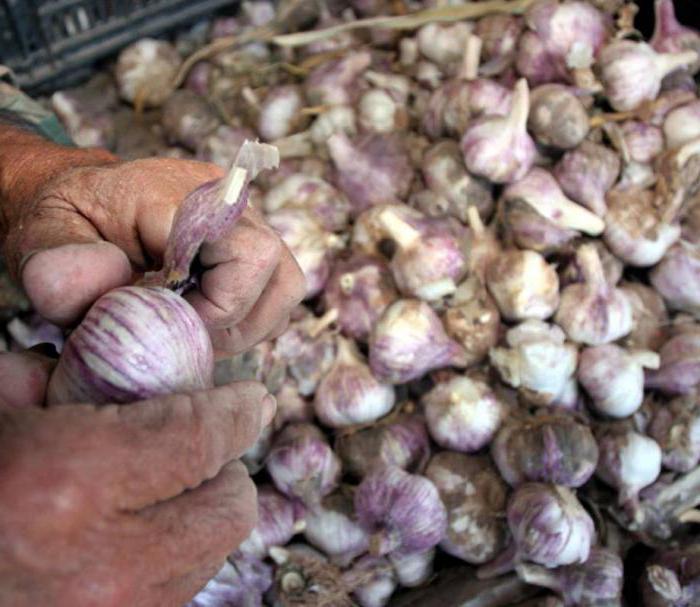

Varieties of winter garlic differ among themselves in the number of cloves, the size and shape of the head, the presence or absence of arrows and the color of the scales covering the cloves. In most cases, it is this type of culture that is planted. In the practice of gardeners there are popular varieties that have managed to prove themselves on the positive side: "Danilovsky local", "Komsomolets", "Gribovsky-60", "Otradnensky" and "Gribovsky jubilee".
Timing
Planting garlic in the fall in each region is carried out in different ways. It depends on climatic conditions and changes in weather. In central Russia, planting work usually takes place in early October, in the northern regions - at the end of the first month of autumn. In the south of the country, this time falls at the beginning of September. The optimal time for planting garlic in the Moscow region was always considered the time that fell on the first half of October.
In recent years, the climate in our country has changed a lot and the autumn weather is full of surprises. It is important to monitor the precipitation and to approach the issue of planting deliberately. During planting, the soil should be moderately moist. You should also build on the weather forecast. If the garlic is planted too early and stays warm for a long time, it will release the greens. Upon reaching a certain growth of the green mass, during the first frosts, the entire crop will be destroyed. Frost clings to small sprouts only on the top, so this will not particularly affect the future development of culture. It needs time to take root, but not let it grow. In garlic, this process takes place within one month.
In regions with a temperate climate, as a rule, the autumn temperature is set at + 10 ºС. Under such conditions, the timing of planting garlic in the Moscow region does not change much. Works in this region are carried out from September 20 to October 15. With sudden changes in temperature, gardeners need to learn to adapt to new conditions and choose more suitable days.
Many farmers are guided by favorable days for planting winter garlic according to the lunar calendar. When the moon is waning, in their opinion, this is the best time to land. Those who follow the signs choose the day of the Feast of the Intercession of the Most Holy Theotokos. Some dwelled on the fact that if the weather is warm throughout November, planting work can be continued.
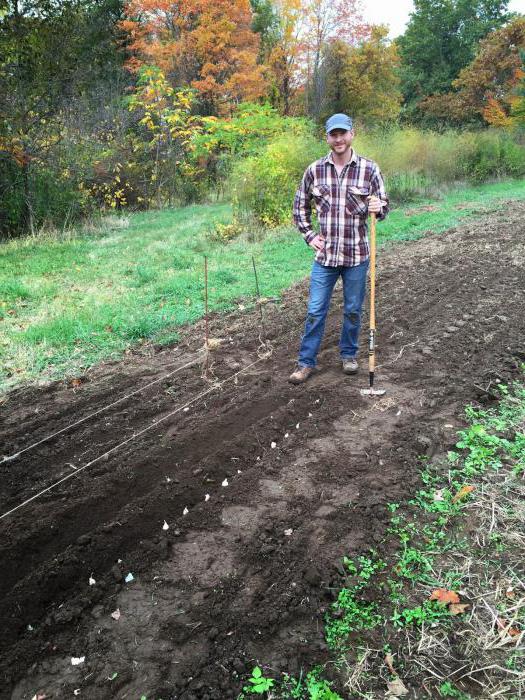

How to distinguish a winter variety
Planting spring garlic takes place in several stages.
When growing garlic, as well as other crops, gardeners also have certain mistakes associated with planting spices and further harvesting.
- As practice shows, in case of violation of the planting dates existing for a particular crop, the quality of the resulting crop is significantly reduced. Of course, winter garlic planted in spring will sprout and bear fruit, however, they will not be what we would like to receive. But these plants will provide you with fresh greenery throughout the summer season.
- Another fairly common mistake of gardeners is the belated planting of garlic, when the average daily temperature is confidently kept above 5 degrees. In such cases, the plants will grow green mass, and not bulbs, until late autumn.
It takes into account soil quality, weather and climatic conditions, planting time and early maturity.
The most popular varieties of garlic, which are planted with cloves before winter:
- Otradnensky. It is characterized by resistance to low temperatures and pests. Has a high yield (1.5 kg per 1 m2). It is medium late and has a spicy taste. Suitable for growing in Ukraine, Belarus, Russia.
- Gribovsky 60 - early maturing, glassy. Head weight - about 50 g. The number of cloves is from 6 to 12. The taste is excellent.
- Gribovsky jubilee. Ripening period is medium late. Suitable for growing in the middle lane. Resistant to drought, frost and waterlogging.
- Komsomolets. The growing season lasts no more than 110 days. Has a pungent taste. Produces a good harvest if all planting requirements have been met.
- Danilovsky local. Recommended for growing in the middle lane. Bulb weight - about 45-50 gr. The taste is less pungent than other varieties. Productivity - 1-1.2 kg / m2.
All varieties are suitable for conservation. Can be used raw.After drying, they are added to spices.
Tricks of planting garlic before winter
CORRECT planting of GARLIC IN AUTUMN (before winter). I share ALL SECRETS!
When to plant garlic before winter in 2020 in the Moscow region
UNIQUE “LAZY” METHOD OF PLANTING GARLIC WITH WHOLE HEADS!
When to plant garlic before winter depends primarily on the planned planting depth.
Naturally, the main difference is that winter garlic is planted before winter, and spring garlic - in spring.
In addition, they can be distinguished by their external features.
| Winter garlic | Spring garlic |
|
|
It is better if tomatoes, cucumbers, legumes grew in the garden before the garlic. Also good precursors of garlic can be early cabbage, zucchini, pumpkin. In this case, the soil for garlic will be maximally saturated with organic fertilizers.
In places that were occupied by potatoes or onions, it is not recommended to plant garlic. This is due to the fact that between these crops there is a high risk of "exchange" of diseases (nematode, fusarium, etc.).
You should also not plant winter garlic in areas where manure was introduced this year: garlic will give abundant tops, loose heads and will be less resistant to fungal diseases.
Find the most fertile soil in your area with normal or low acidity. It is in this place that you should plant the garlic. Make a bed on the sunny side, placing it from north to south.
Preparation for planting winter garlic begins early.
Now we proceed directly to the technology of planting garlic in the fall.
There is another, less familiar approach to preparing a garden for winter garlic.
Consider the important points and prerequisites for planting garlic in the spring.
First, you need to choose a suitable site that must meet a number of requirements:
- The best are such soils: black soil, loam, and also light and medium soils.
- Planting and caring for garlic outdoors should be carried out in areas where potatoes, tomatoes and onions have not been grown before. Suitable precursors include cabbage, legumes and cucumbers.
- Please note that you should not plant garlic in the same place every year.
- The plant prefers warmth and light, so choose a lighted area. It needs to be prepared: dig up, loosen and remove weeds. You can pour the earth with saline (3 tablespoons are taken in a bucket of water). After two days, you can land.
The scheme and the landing depth were described above, but some of the nuances were missed. Spring varieties need careful watering until mid-July, when there is an active growth process. With an excess of moisture, the growth of the bulbs is delayed, and the storage of garlic will not work for a long time. If there is not enough water, the tips of the plant will begin to turn yellow.
- After watering the next day, be sure to loosen the beds so that oxygen can flow to the plant.
- At the beginning of August, it is necessary to tie all the leaves in a knot in order to thereby reduce their nutrition. As a result, the garlic will devote all its strength to the formation of a large head.
- Timely renewal of the variety contributes to a good harvest.
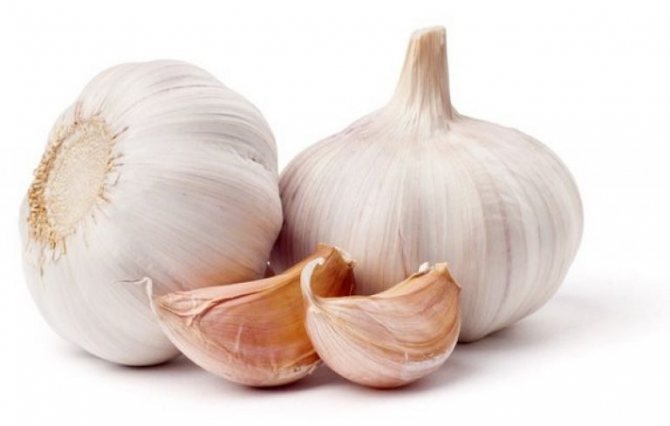

Planting garlic before winter will ensure excellent quality and large size of heads and chives. We will tell you how to plant garlic in the fall.
Naturally, the main difference is that winter garlic is planted before winter, and spring garlic - in spring.
| Winter garlic | Spring garlic |
|
|
DETAILS: Is it possible to soak cucumbers for 12 hours before pickling
It is better if tomatoes, cucumbers, legumes grew in the garden before the garlic. Also good precursors of garlic can be early cabbage, zucchini, pumpkin. In this case, the soil for garlic will be maximally saturated with organic fertilizers.
In places that were occupied by potatoes or onions, it is not recommended to plant garlic. This is due to the fact that between these crops there is a high risk of "exchange" of diseases (nematode, fusarium, etc.).
Planting garlic before winter
There is another, less familiar approach to preparing a garden for winter garlic.
It is worth saying that planting garlic for the winter will depend on how deep you plan to plant the vegetable.
The quality and quantity of the harvest depends on the precursors of garlic. Garlic grows best where previously grown annual vegetables such as legumes, tomatoes or cucumbers.
Good soil remains after growing pumpkin, zucchini or cabbage, they saturate the earth with various organic matter.
If onions were grown in the garden, it is worth taking a break of 3-4 years, only after that use the soil under the garlic. It is also worth being careful with the soil after potatoes, because garlic can become infected with fusarium or nematode.
In addition, avoid planting in soil that has recently been flavored with manure, because garlic will produce too abundant tops, which will make it unprotected against fungi and other diseases.
In order for a vegetable to be born, you need to find the best soil, the acidity of which will be normal or reduced. It is recommended to place the bed where it will be as sunny as possible, preferably from the north to the south.
Any variety of garlic for the winter is characterized by excellent frost resistance, as well as good yield indicators. However, among all the variety of varieties presented, you have to choose only one. We will learn how to choose the best winter garlic variety.
| Signs of a winter variety | Signs of a spring variety |
| The head has 5-10 large teeth, while they are covered with a purple sheath. The teeth are located one at a time strictly around the solid middle | There is no rod in the head, the number of teeth is usually about 20, arranged in several rows |
| The taste is pungent and pungent | Soft taste |
| Not stored in winter | Stores well, until the onset of spring |
There are winter and spring varieties. They differ in appearance, taste and planting period. Neither one nor the other should be planted in the same place every year. These plants consume a lot of nutrients, the soil must have time to "rest" after harvesting the garlic. Planting a plant after nightshades (tomatoes, peppers, potatoes and others) is also undesirable.
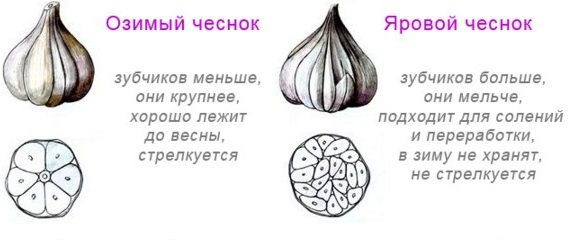

It is worth paying attention to the size and location of the teeth of each variety.
Before planting garlic for the winter, prepare the soil. Winter varieties need loose and fertile soil, so fertilization should be added a couple of weeks before planting, and preferably 1.5 months - immediately after the previous harvest.
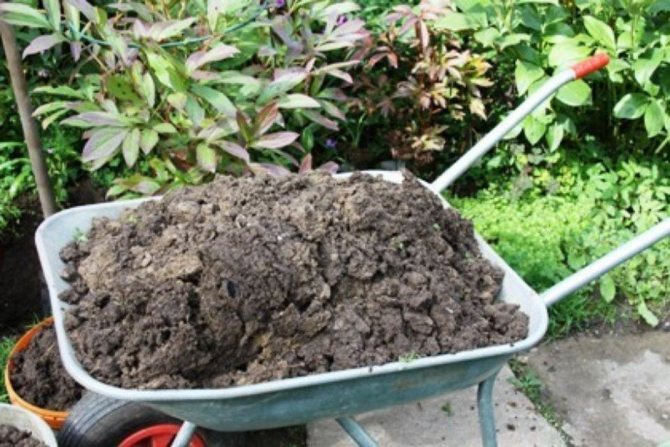

Bulbous plants consume a lot of nutrients, so you can not save on fertilizing the soil, for every square meter of land it takes up to one bucket of humus or compost
To prevent the teeth from freezing in a harsh winter, they should be placed at a depth of 10 centimeters. Usually, winter varieties are planted in the second half of September or in October, before frosts. Some farmers follow a number of traditions. So, according to one of them, garlic should be planted on the Orthodox holiday of the Intercession of the Holy Mother of God - October 14.Other gardeners believe that the best time to work on the ground is during the period when the moon is in the waning phase.
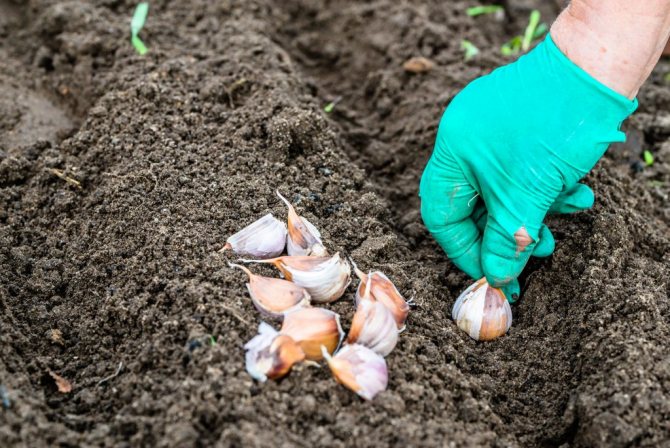

In fact, the average daily temperature in the region is of great importance. If the garden is located in the southern parts of the country and winters come much later, there is a risk that the plant will take root and grow prematurely. This will have a detrimental effect on the future harvest.
| Winter garlic | Spring garlic |
|
|
Reproduction
The most common way of growing garlic is when the head is divided into separate cloves, and then they are planted.
Seeds can be harvested from winter varieties for propagation of this crop. When you remove the arrows, some of the most beautiful and largest are left in the garden. By the end of summer, each peduncle forms many bulbs. They are removed after final ripening, without waiting for the moment when the upper shell bursts.
Having planted air seeds, next season it will be possible to harvest garlic sets. It consists of small bulbs, from which heads with several cloves subsequently grow.
How should a germinated root be rooted?
Garlic sprouted in spring can be planted in the garden both in April and in May. By the fall, large bulbs (one-toothed) will appear. They can be left in the ground (harvest next year), or dug up and used as seed.
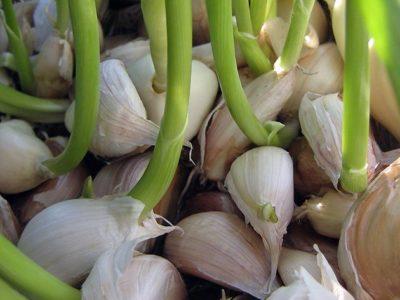

Planting sprouted garlic at home in boxes is as follows:
- Go through the heads, remove the unusable ones.
- Divide into parts, discarding diseased teeth.
- Trim dry roots carefully.
- Soak the sprouted teeth in a 0.5% solution of potassium permanganate for 2-3 hours. Solution temperature up to 40 ° С.
- Plant the softened and disinfected cloves in a container, in which to fill the garden soil to the bottom.
- Water the plants in moderation before getting wet.
- Before rooting, the boxes of garlic should be removed to a cool place (no more than + 12 ° C).
Preparation of planting material
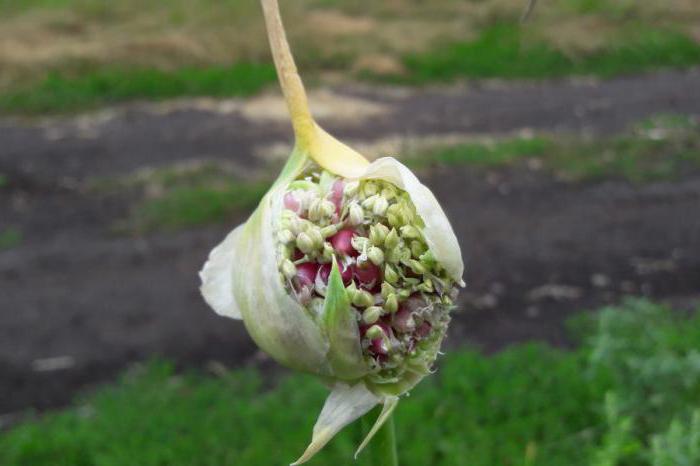

The preparation of garlic for planting is determined by what type of material will be used - cloves, one-toothed (seed grown from seeds) or bulbs.
Plain chives. Due to the fact that diseases of cultivated plants are a fairly common phenomenon, the processing of planting material is a necessity. Whether it is necessary to soak the garlic before planting depends on whether it was disinfected with a suspension. If the teeth have not been subjected to such a procedure, then they must be soaked in a manganese solution of medium dilution (pink) for 5-10 hours. Such a preventive measure not only prevents diseases of future seedlings, but also has a healing effect.
Read also Tomato chocolate apples reviews
To avoid soaking, the planting material can be pickled. This procedure takes much less time. How to process garlic before planting before winter? The selected cloves are placed in a solution of copper sulfate or a suspension "TMTD" intended for this and kept for only 15 minutes.
Air bulbs. The bulbs obtained from the peduncle arrow should also be prepared before planting. You need to use those seeds that have been well dried and stored at room temperature, in a dry place. A month before planting, a thin film is removed from them and placed in the refrigerator. If you ignore this event, then the bulbs obtained from air seeds will not have time to take shape by autumn.In the future, the heads grown from such material will be deformed and small.
Whether it is necessary to soak the garlic before planting as seeds is a matter of choice. The sevok obtained from them will still need to be selected in order to reject small and damaged one-toothed ones. For reinsurance, you can disinfect the planting material in a solution of wood ash. Very small seeds and those that float are best discarded immediately.
Garlic sets. When selecting one-toothed teeth, you need to pay attention to their color, especially if these are varieties with a purple tint. You need to choose brighter and larger bulbs in order to preserve the varietal qualities of the culture. Sometimes heads with several teeth come across among them. This material is very valuable because it grows very large garlic.
Now you need to decide how to process the garlic before planting before winter. In addition to the above methods, garlic sets can be soaked in salt water (10 tablespoons of salt in a bucket of water). Good results are obtained by treatment with iron vitriol. One tablespoon of this substance is enough for a bucket of water. The allowable time for such disinfection is 15 minutes. Garlic can be kept in salted water for about 3 hours.
Possible problems and difficulties
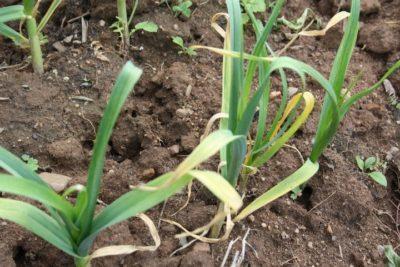

When planting garlic, the following problems may arise:
- If the plant grows after the autumn planting, it may die from frost.
- If the plant does not have time to take root before frost, then in the future it may rot or freeze.
- It is necessary to ensure that plantings in the spring are not flooded with autumn rains and melt water.
- If the site for planting is infected with fungal infections, then treat the soil with copper sulfate.
Precautionary measures taken during the planting stage can help to avoid the following diseases:
- Defeat by rot. This is reflected in the rotting of the bulbs, the death of the root system, the leaves turn yellow. White bloom may also appear on the roots. The choice of a high-quality planting variety and treatment with disinfectants on the eve of planting will help prevent this.
- If garlic plants are affected by onion flies, then treat the bushes with a mixture of wood ash (1 tbsp), tobacco dust (1 tsp) and black pepper (1 tsp). Loosen the soil after cultivation.
- The emergence of nematodes can be prevented during the seed preparation stage by soaking it in saline.
Having familiarized yourself with the technology of planting garlic, and applying it in practice, you can grow a bountiful and healthy harvest already in the next sowing season. The main thing is to accurately observe the planting dates and use high-quality seed.
Garden bed
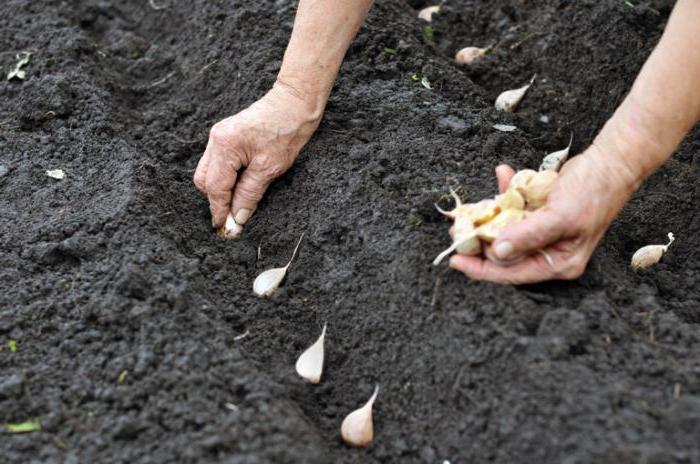

- The first rule of planting garlic is to choose the right site. The place should be well lit. The size and quality of the head often depends on the condition of the green part of the plant. In the shade, the feathers of this culture are usually thin, yellowed and stretch upward.
- It is important to observe the crop rotation. Where pumpkin crops, peas, cabbage and greens grew, garlic will grow better. In the old place, and where the onion was grown, it is undesirable to plant this crop.
- The garden for planting garlic should not be organized in a place where there are spring floods or excessive humidity. A bad choice can lead to a complete loss of the crop.
- The scheme of planting garlic before winter also depends on the preliminary preparation of the soil. If additional fertilizers need to be applied to the tooth recesses just before planting, then they are made deeper. For example, when adding ash, it will need to be mixed a little with the soil, and this technique requires more space.
- Garlic loves to grow on light loams. Dolomite powder or fluff lime must be added to acidic soils. It is not necessary to apply fresh manure, as this will lead to deformation of the fruit.
- Clay soil is enriched with peat and sand, and sandy - with a mixture of clay. It is not difficult to prepare it: 2.5 buckets of clay are taken per 100 liters of water and stirred well. The area is watered with liquid before digging.
- Before planting work, you need to add 30 g of mineral fertilizers (potassium sulfate + superphosphate) per 1 m 2 and scatter wood ash.
Some Recommendations
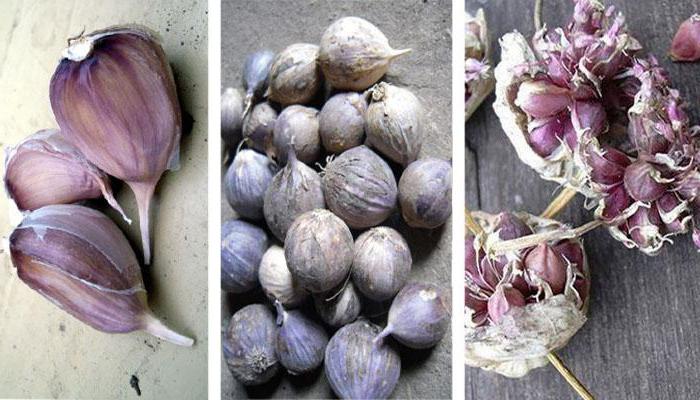

For seeds, it is necessary to select the largest heads of garlic, and of them - the best cloves. This principle applies to puffed seeds as well as bulbs. The peculiarity of this culture is such that large garlic will never grow from a small clove.
When immersed in the ground, the planting material must not be pressed in, so as not to break the roots.
If the site is in partial shade, the teeth are planted less often. This will allow the head to form better.
When planted together, garlic coexists well with strawberries.
What tools are used?
There are various attachments for planting vegetables. A smart choice will make the job easier. Garlic planting tools:
- Manual garlic planter. It is a simple, economical mechanism that is manually transported and adjusted. It will suit those gardeners whose possessions are not large. This mechanism must maintain a straight line when planting, deepen the soil to the desired depth, and place the tines evenly.
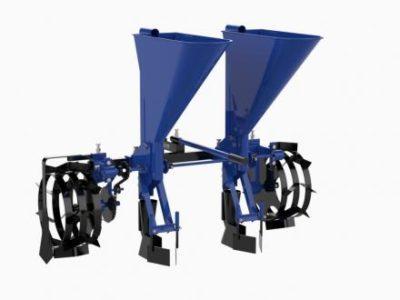

Seeder for garlic. A device that makes the planting process less laborious. Effective for large amounts of land given over to garlic. The soil is pre-prepared by leveling. The principle of operation is that the opener cuts grooves into which the seeds are placed. Then the openers cover the teeth with soil and huddle the beds.- Seeder with mini tractor. Greatly reduces the time spent on work, but requires a lot of fuel consumption. Packing rollers help complete the planting process. The ability to use cloves and "bulbs" as planting material.
- Homemade garlic planter. A step is welded to a metal pipe. To form a hole in the ground, you should put your foot on the step and press on it. A clove of garlic is placed in the resulting hole and covered with soil mixed with ash.
You can learn more about the varieties of garlic planters here.
Planting cloves
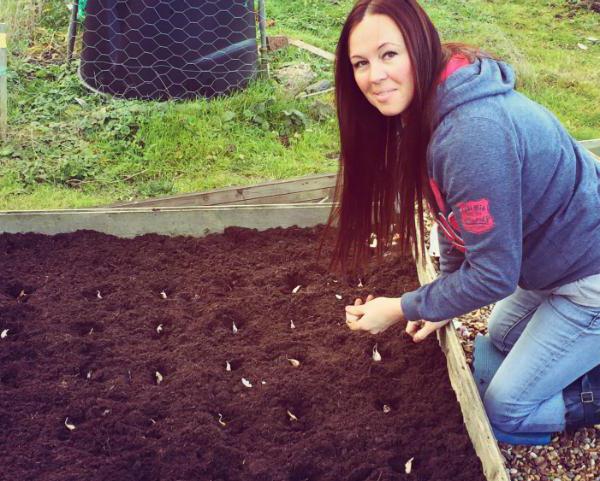

There is a standard scheme for planting garlic before winter, which has been used by many farmers for a long time. With this method, the gaps between the grooves are usually left no more than 30 cm. If the area is small, then the minimum distance should be 20 cm. The depth of the grooves depends on the structure of the soil. If the soil is loose and well-permeable, then the cloves are planted to a depth of 6-7 cm. The top layer of the earth needs to be compacted a little so that it does not erode. On denser soils, the seed is deepened by 5 cm.
Observing the depth of planting of garlic before winter, it is important to take into account the weather conditions. In regions with a harsh climate, it is planted deeper and insulated. In most of Russia, where a lot of snow falls, areas with garlic need not be covered, since it is well preserved under a natural cover. In such areas, planting is carried out at a depth of about 4 cm.The distance between the chives during planting is 9-10 cm.
Many gardeners practice growing this crop in special beds. With this method, there is no need to walk between the rows of plants. Tall structures for growing various vegetables, the width of which is 80-100 cm, have become very popular. The scheme for planting garlic in the fall in such a bed will be different. The row spacing is significantly reduced. Seed material is planted in a checkerboard pattern, with an interval of 8 cm in a row and between the cloves. The depth rules remain the same.
Read also Increasing the winter hardiness of fruit with cryogel
An additional covering layer should be no more than 2 cm. It is created from peat or humus, and hay or foliage is applied on top.
Agrotechnical care measures
- How to cover garlic for the winter?
To protect the plantings of garlic from frost, it is recommended to cover them with a layer of peat or sawdust mixed with soil (about 2 cm). Dry leaves and stems of plants (up to 10 cm) can be used as mulch. From above, the mulch can be covered with a film, roofing felt or other covering materials.
Even spruce branches or branches scattered over the site will help trap snow and create a snow blanket.
- When to open garlic in spring?
The opening of the garlic is started in early spring after the snow melts. The plant begins to grow at temperatures above 5 ° C, and by this time the planting should be free. If you are late in removing the shelter, you can damage the hatched shoots or they will die without breaking through the thickness of the shelter.
- Top dressing.
Better feeding - a solution of cow dung (1:10) or bird droppings (1:20). The first feeding can be done with urea after germination, the next in June - with an ash solution (200 g per 10 l of water).
Spring
As already mentioned, the spring type of garlic does not produce flower stalks, so it is planted only with chives. Unlike winter varieties, it does not yield such bountiful yields. But its plus is that it is better preserved. Even in spring, the heads and chives of spring garlic have an excellent appearance. Some varieties can be stored for more than a year. Another difference of this species is the large number of cloves. The largest are selected for planting.
The planting work of the spring crop begins in April, when the daytime temperature stabilizes and will keep not lower than +5 ºС. Like winter varieties, it is planted according to a specific pattern. Garlic is planted in moist soil. You need to dig the grooves and fill them with water. When it is absorbed, evenly distribute the cloves at a distance of 7 cm.They should be deepened so that the top layer of soil covers the planting material by 2 cm.
What soil to plant
The place for planting garlic must be prepared in the fall. The best choice for planting is neutral soil. Garlic strongly dislikes acidic soil. The acidity of the soil can be reduced. For this, you can use saltpeter, chalk, dolomite flour. Winter varieties like sandy loam and loamy soil. It is a mistake to use manure to fertilize the soil. This plant does not like this kind of fertilizer. Moreover, the manure can contain various harmful microorganisms and larvae of possible pests.
Planting air seeds
Bulbs are planted on well-fertilized soil. It is fertilized with humus, compost and a complex of mineral fertilizers.
The scheme of planting garlic in autumn with air seeds differs significantly from the standard one. They are sown in long rows, the intervals between which are 9-10 cm, and the interval between the bulbs is 2. The grooves are made no deeper than 3-4 cm.
There is a well-known method of growing garlic from air bulbs. In the first year of planting, the formed bulbs are not dug up. They are left to grow for the next season and get ready-made heads of this culture. In this case, air seeds must be sown at the same distance as regular garlic cloves.
Is it possible and how to properly grow from seeds?
In addition to cloves and one-toothed garlic, you can plant garlic using seeds (bulbs), which the arrowhead plant varieties form on the flower stems.
There are the following planting methods:
- Growing a plant in seedlings with transplantation. The principle is that the seedlings are planted in the same year before winter, or next spring. Then he is transplanted to a new place.
- Seedless. In this way, garlic is grown by planting seeds in the soil. If the garlic is winter, then full-weight cloves, one-toothed bulbs and bulbs are used. It will take two seasons to grow a ready-made bulb from a bulb, and one from a clove. Bulbules with this method are not dug out, leaving to overwinter. A year later, a larger onion is taken out at this place.
You need to choose a planting method based on the climatic conditions of the area, the availability of planting material, and variety.
Planting one-toothed
Planting garlic sets gives very good results. First, there is a renewal of seed material, which must be periodically carried out to preserve the varietal characteristics of the crop. Secondly, very large heads grow from it. Such garlic does not get sick and is more adaptable to weather changes.
The bulbs are planted according to the general rules for planting garlic. They should not be deepened too much. If necessary, cover the beds with mulching material. For them, you can also create a layer of fertile shelter of peat or compost. Before frost, the beds need to be covered with more reliable material, for example, dry grass or sunflower husk. The suitable planting depth for garlic before winter is no more than 3-4 cm.

